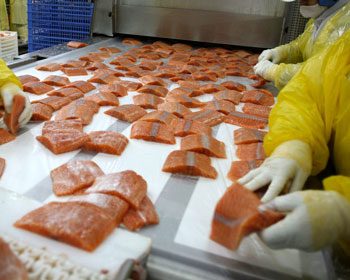Demand for salmon in the Western world and beyond is growing – and will continue to do so. However volatile prices are not sustainable in the long run judging by an analysis by the Netherlands-based, Rabobank.
There’s much to celebrate about in Rabobank’s “Keeping Salmon On Top Of The Menu – How To Maintain The Hugh Demand.” Analysts Beyhan de Jong and Gorjan Nikolik summarise that the pink fish has outpaced growth in all other proteins – effectively “winning the battle of the proteins” such as pork, poultry, beef, and wild-caught seafood and that trend will continue to do so.
Three factors
Rabobank attributes growth to three factors: consumer trends favouring salmon consumption, the unique feature of the salmon supply chain compared with other seafood categories, growth strategies through new markets and new value-added products. These will also support further growth, the report noted.

Consumer trends have shifted towards seafood but farmed fish has increased at the expense of wild-caught. “In the last ten years, European consumers increased aquaculture seafood consumption by almost 1kg per person, reaching 6kg,” – with salmon as the top choice in both US and EU markets.
Supply chain
Rabobank attributes the fish’s success down to industry’s tech-embracing established year-round supply chain. “No other seafood species can replicate this in Western markets,” it wrote.

Volatile prices
The report observed that salmon demand will increase – on both established and new markets (“where salmon is not entirely discovered yet”). For example, opportunities wait for those in Spain where salmon was the only seafood category that grew in comsumption in the past decade. There is also still huge potential for the world’s second largest consumer, the USA, to grow even more. China and Brazil were also singled out as candidates for growth.
The report noted that volatile prices – which have risen faster than other competing proteins – could hinder growth. And in conclusion, the industry’s biggest obstacle would be the failure to embrace sustainable alternatives – or to lose its mantle as the de-facto “affordable luxury.”

